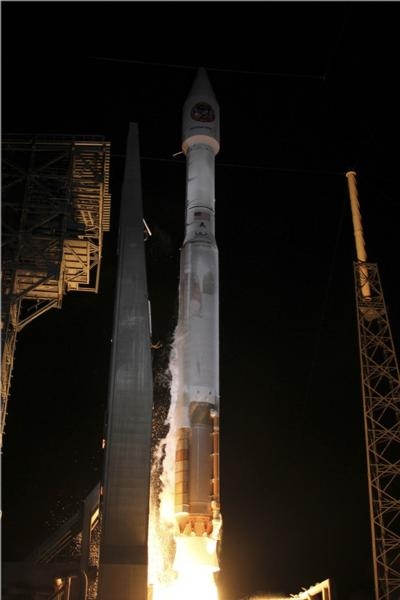ULA Boosts 7,745 Pounds Of Cargo To The Station
A United Launch Alliance (ULA) Atlas V rocket carrying the OA-6 Cygnus resupply craft to the International Space Station (ISS) lifted off from Space Launch Complex-41 on March 22 at 11:05 p.m. EDT.

Approximately 21 minutes later, the spacecraft successfully separated from the Centaur upper stage at its initial orbit, where it will rendezvous with the ISS. The mission was flown for Orbital ATK under NASA’s Commercial Resupply Services contract, and, with a payload of more than 16,000 pounds, was the heaviest payload to launch on an Atlas V to date.
The Cygnus is scheduled to arrive at the orbiting laboratory Saturday, March 26.
“ULA is honored to be a part of the team that delivered more than 7,700 pounds of cargo to the astronauts aboard the ISS and CubeSats to be deployed after Cygnus separates from the ISS,” said Gary Wentz, ULA vice president, Human Launch Services. “Congratulations to our mission partners at Orbital ATK and NASA on another successful launch that will help advance our scientific knowledge on Earth and in space, and inspire the next generation of space explorers.”
This mission was launched aboard an Atlas V Evolved Expendable Launch Vehicle (EELV) 401 configuration vehicle, which includes a 4-meter-diameter extra extended payload fairing. The Atlas booster for this mission was powered by the RD AMROSS RD-180 engine and the Centaur upper stage was powered by the Aerojet Rocketdyne RL10C-1 engine. It was the ULA’s third launch in 2016 and the 106th launch since the company formed in 2006.
“I am also extremely proud of our engineering and mission integration teams as this vehicle flew the first flight of the upgraded boattail,” Wentz said. “With every launch, we build upon our years of experience and continue to find new and better ways to launch our customers’ payloads to orbit in an efficient and cost-effective manner.”
ULA's next launch is the MUOS-5 satellite for the U.S. Navy, scheduled for May 5 from Space Launch Complex-41 from Cape Canaveral Air Force Station, Florida.
Scientific investigations of fire in microgravity and grippers inspired by geckos are among the experiments being delivered to ISS, according to the Kennedy Space Center.
The station’s Expeditions 47 and 48 crews will employ these science payloads to support experiments in biology, biotechnology, physical science and Earth science – research that improves life on Earth -- including:
- Saffire-I provides a new way to study a large fire on an exploration craft, which has not been possible in the past because the risks for performing such studies on spacecraft with astronauts aboard are too high.
- Meteor will enable the first space-based observations of meteors entering Earth’s atmosphere from space.
- Strata-I could give us answers about how regolith behaves and moves in microgravity, how easy or difficult it is to anchor a spacecraft in regolith, how it interacts with spacecraft and spacesuit materials, and other important properties.
- The Gecko Gripper study tests a gecko-inspired adhesive gripping device that can stick on command in the harsh environment of space.
- The Additive Manufacturing Facility will add an upgraded 3-D printing capability to the station.
NASA astronaut and Expedition 46 Commander Tim Kopra will capture Cygnus at about 6:40 a.m. Saturday, March 26, using the space station's Canadarm2 robotic arm to take hold of the spacecraft. Astronaut Tim Peake of ESA (European Space Agency) will support Kopra in a backup position. NASA TV coverage of capture will begin at 5:30 a.m.
Saffire-1 will remain on the spacecraft once all the other supplies are unloaded, and the vehicle will be attached to the space station for about two months. Once it departs and the spacecraft is a safe distance from the space station, engineers will remotely conduct the first Saffire experiment before the Cygnus’ destructive reentry into Earth’s atmosphere. Before detaching from the station, Cygnus will also be filled with about 3,000 pounds of trash, which will be burned up over the Pacific Ocean.
(Source: ULA and NASA news releases. Images provided by NASA)
 Senator Pushes FAA to Accelerate Rocket Launch Licensing
Senator Pushes FAA to Accelerate Rocket Launch Licensing Classic Aero-TV: RJ Gritter - Part of Aviations Bright New Future
Classic Aero-TV: RJ Gritter - Part of Aviations Bright New Future Aero-FAQ: Dave Juwel's Aviation Marketing Stories -- ITBOA BNITBOB
Aero-FAQ: Dave Juwel's Aviation Marketing Stories -- ITBOA BNITBOB ANN's Daily Aero-Linx (10.27.24)
ANN's Daily Aero-Linx (10.27.24) ANN's Daily Aero-Term (10.27.24): Clearance Void If Not Off By (Time)
ANN's Daily Aero-Term (10.27.24): Clearance Void If Not Off By (Time)



